Spirea: planting, care, species and varieties
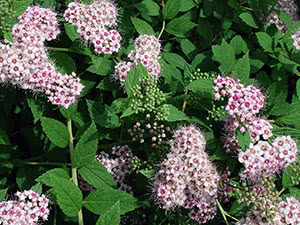 Spirea (lat. Spiraea),, or meadowsweet, is a genus of ornamental deciduous shrubs in the rose family (Rosaceae). The name of the plant is derived from the ancient Greek word “speira” that means “bend”, and the validity of this name is confirmed by the extra flexibility of its shoots. The main virtue of spirea is its unpretentiousness. There are about a hundred species of spirea growing in the steppe, forest-steppe and semi-deserts.
Spirea (lat. Spiraea),, or meadowsweet, is a genus of ornamental deciduous shrubs in the rose family (Rosaceae). The name of the plant is derived from the ancient Greek word “speira” that means “bend”, and the validity of this name is confirmed by the extra flexibility of its shoots. The main virtue of spirea is its unpretentiousness. There are about a hundred species of spirea growing in the steppe, forest-steppe and semi-deserts.
The mention of spirea, or rather meadowsweet, can be found in the Russian heroic epic "Sadko" (circa 1478), then in the 19th century information on this plant was included in the dictionary of V. I. Dahl: he wrote that strong and thin branches of meadowsweet were used for ramrods and whip handles. Today different species and varieties of spirea are cultivated, and all of them are characterized not only by high ornamentality but also by frost resistance and duration of flowering.
Spirea shrub – description
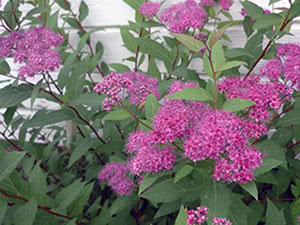 РPlants of the spirea genus can be both dwarf (6 inches) and very tall (up to 8.2 ft). The root system is shallow, fibrous. Branches can be creeping or straight, wide spread or decumbent, the color ranges from light to dark brown, the bark has the property of peeling longitudinally. Leaves are petiolate, alternate, three-five lobed, lanceolate or rounded. Spirea flowers are small, but numerous, forming a variety of inflorescences – paniculate, spicate, pyramidal, corymbose. Flower color is diverse, from bright white to crimson. The inflorescences of different spirea species are located differently: some of them are arranged along the entire stem, others are only on the upper part of the shoot, some are only at the ends of the branches. Spirea is propagated by bush dividing, seeds, layers and cuttings.
РPlants of the spirea genus can be both dwarf (6 inches) and very tall (up to 8.2 ft). The root system is shallow, fibrous. Branches can be creeping or straight, wide spread or decumbent, the color ranges from light to dark brown, the bark has the property of peeling longitudinally. Leaves are petiolate, alternate, three-five lobed, lanceolate or rounded. Spirea flowers are small, but numerous, forming a variety of inflorescences – paniculate, spicate, pyramidal, corymbose. Flower color is diverse, from bright white to crimson. The inflorescences of different spirea species are located differently: some of them are arranged along the entire stem, others are only on the upper part of the shoot, some are only at the ends of the branches. Spirea is propagated by bush dividing, seeds, layers and cuttings.
Spirea flowers are used for group plantings and hedges. Dwarf spirea varieties are perfect for rockeries, stone gardens and for creating ground cover. The spirea bush looks great as a single plant.
Species and varieties of spirea
Some species and varieties of spirea are used often in cultivation, the others are used occasionally. Depending on the time of flowering, there are spring- and summer-blooming spireas.
Spring-blooming spireas
They are characterized not only by an early flowering, but also by exceptionally white color of flowers that bloom on the last year's shoots. Flowering begins only when the shoots are 2 year old. A heavy tillering is typical for these spireas. In cultivation the following species are popular:
Spiraea cinerea
It is a hybrid of Iberian meadowsweet (spiraea hypericifolia) and spiraea cana – in fact, this is a white spirea, and it is called gray because of the color of the leaves. The bush reaches a height of 6 ft, branches are drooping, lanceolate gray-green leaves have gray underside, corymbose clusters of white flowers are located along the entire branch. It blooms from the middle of May till the middle of June. The most popular varieties are:
Spirea Grefsheim: diameter and height of the bush of this variety is 5-6.5 ft, the branches are arching, the head is sprawling, the branches are red-brown, flowers are up to 0.4 inch in diameter, snow-white, double, collected in umbrellas. This spirea is a honey plant, it blooms for up to 45 days, starting from the second year of growth;

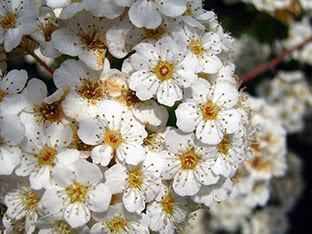
Vanhouette spirea
It is a hybrid of reeves spirea and three-lobe spirea. Diameter and height of the bush is up to 6.5 ft, the branches are arching, the leaves are dentate, glabrous, trilobate, the upper side of the leaf is dark green, the underside is bluish, in autumn the leaves turn red-orange. Numerous hemispherical clusters consist of white flowers 0.2 inch in diameter and are located along the entire branch. It blooms in the middle of June, sometimes it reblooms in August;
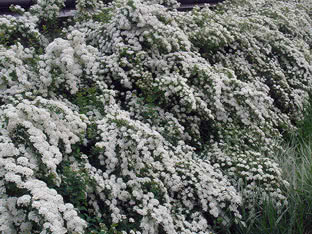

Spiraea nipponica
In nature it grows on the island of Honshu, reaching 6.5 ft in height, the head is spherical, dense, the branches are horizontal, the leaves are green till late autumn, up to 1.7 inch in length, it blooms for up to three weeks in early June with corymbose clusters consisting of yellow-green flowers up to 0.4 inch in diameter, and the buds are purple;


Spiraea Arguta
It is the earliest spring-flowering spirea. The spreading bush is 5-6.5 ft high of a very beautiful shape. Its arching flowering branches, like a foamy waterfall, consist of numerous snow-white fragrant flowers, flowing along the entire branches. Arguta blooms for three weeks at the end of May.
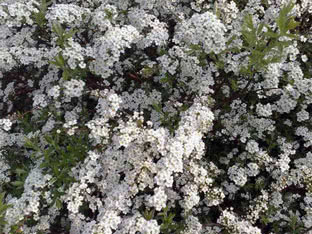

Summer-blooming spirea
These are species the clusters of which are formed at the ends of young shoots and the old last year's shoots gradually dry up. They are primarily represented by the varieties of Japanese spirea. Most of its varieties are pink, but it can also be a red or red-pink spirea. So the species are:
Japanese spirea
This spirea has very beautiful bushes with felt-pubescent shoots when they are young, and bare shoots when they grow old. The height of the bush is 3.3-5 ft, the leaves are oblong, ovate, the underside is bluish, the upper side is green, in autumn the leaves turn yellow, red, purple. It blooms for up to 45 days with red and pink flowers collected in paniculate-corymbose clusters located at the tips of shoots. The most popular varieties are:
Japanese spirea Little Princess is a shrub with a height of only 2 ft, the diameter of the head is 4 ft, the crown is rounded; the leaves are oval, dark green; the corymbose clusters consist of red-pink flowers 1.2-1.6 inches in diameter. It blooms in June -July and it grows very slowly;
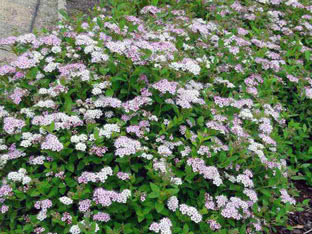
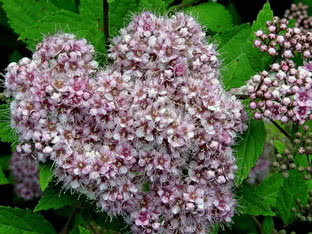
Japanese spirea Golden Princess is a form of the previous variety, the difference is that it grows 3.3 ft in height and the color of its leaves is yellow;
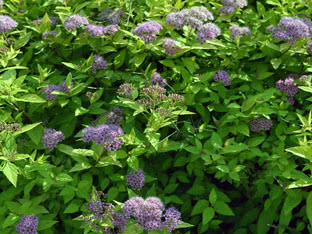
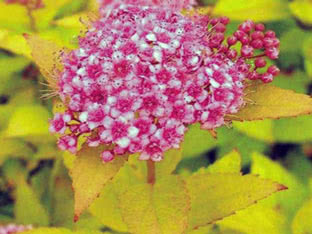
Japanese spirea Shirobana is a low shrub (2-2.6 ft), the head diameter is 4 ft, the leaves are narrowly lanceolate, dark green, small (0.8 inch). White or pink flowers bloom in July or August;
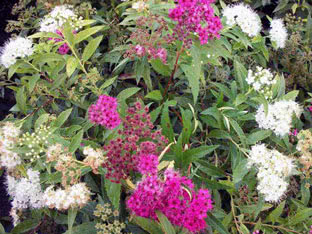
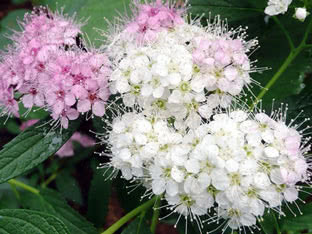
Japanese spirea Goldflame has a height of 31.5 inches, the leaves are yellow-orange that turn bright yellow after some time and then they become green-yellow, in autumn they are copper-coloured. Flowers are red-pink, small;
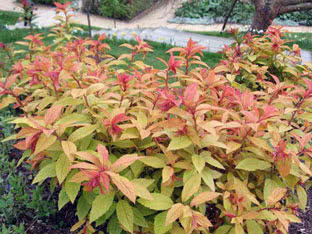
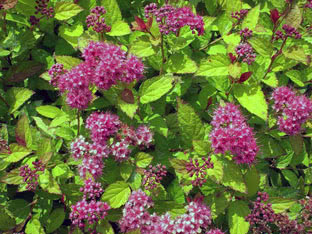
Japanese spirea Crispa is a delicate low shrub, the height is up to 20 inches, the width is a little more than 20 inches, the crown is spherical, numerous shoots are upright, flat clusters are 2.2 inches in diameter, the flower color is tender pink with purple tint, it starts blooming from July for 1.5-2 months.

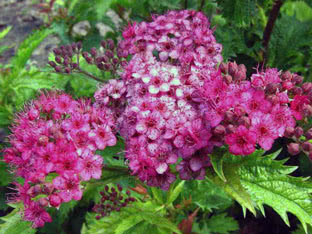
In addition to Japanese spirea, there are also such summer-blooming species of spirea as:
Spirea Bumalda
It is the hybrid of Japanese and white Japanese spireas. It is a low shrub, the height is from 20 to 31.5 inches. The shoots are upright. The leaves are green in summer and in autumn they are especially exquisite – red, purple, yellow. It blooms for about two months, beginning in July, flower colors range from pale pink to dark pink. Popular varieties are:
Spirea Bumalda Goldflame is spiraea with a height of 31.5 inches, young leaves are bronze colored, then they turn yellow-golden followed by yellow-green, in autumn they are copper-red. But these changes occur if the bush is in full sun, in the shade the leaves stay green;
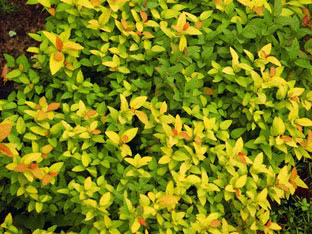
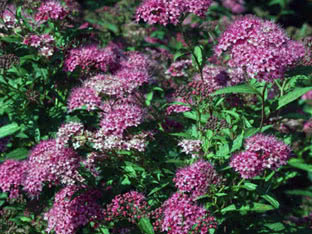
Willow-leaved spirea
It is a 6.6 ft bush with straight shoots of red-yellow-brown color, pointed leaves are up to 4 inches in length, white or pink flowers are collected in pyramidal paniculate clusters about 8 inches long;
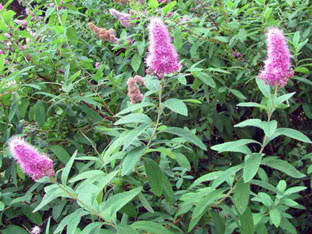
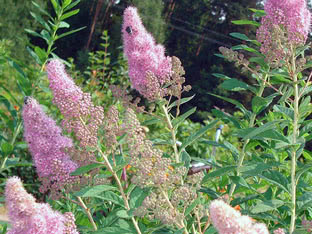
Douglas' spirea
It is a 5 ft bush with straight, pubescent red-brown shoots. Leaves are 1.2-4 inches long, oblong-lanceolate. Dark pink flowers are collected in apical, narrow paniculate-pyramidal clusters. It blooms for a month and a half from July to September;


Spiraea billardii
It is the hybrid of Douglas’ and willow-leaved spireas. The height of the bush is up to 6.6 ft, the leaves are broadly lanceolate, up to 4 inches long, the flowers are bright pink, collected in 8 inch narrow pyramidal-paniculate inflorescences. It starts blooming in the mid-July.

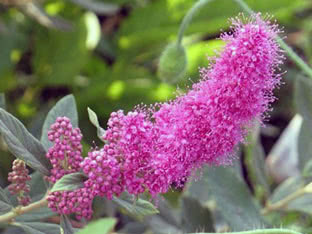
Peculiarities of spirea growing
Each plant has its own requirements for planting and caring. Growing of spiraea also has its own characteristics:
- spirea prefers leaf or sod soil. Optimal composition is one part of sand and peat and two parts of soil;
- a drainage layer is mandatory, you can use broken brick;
- planting of spiraea is carried out in a hole that is a third more than the volume of the rootball of the plant;
- the depth of planting is not less than 20 inches, the root neck of the plant should be even with the surface;
- you need to plant spirea in cloudy weather, or in the rain (that would be even better). The best time is September;
- the best neighbors for spirea are juniper, spruce, cedar.
Planting of spirea
Planting of spirea in spring
Only summer flowering spireas are planted in spring. The main requirement for a spring planting is to plant spirea before sprouting of the leaves. If you buy spirea seedlings, carefully inspect the roots – they should not be over-dried. Check the state of seedling shoots, and buy them only if they are flexible and have good buds. Put in order the planting material: if the roots of the seedling have overgrown, trim them carefully; if, on the contrary, the roots are too dried or damaged, cut off the branches. If the root system got over-dried during the storage, water or soak it for a short time in a bucket of water, and then plant it.
Spirea is a low maintenance plant, but to achieve a long and abundant flowering it is necessary to follow some rules: the area for spiraea should be in full sun, the soil is fertile. In addition, spiraea bushes produce lots of root suckers that increase the area occupied by the plant, and this should be taken into account when planting spirea.
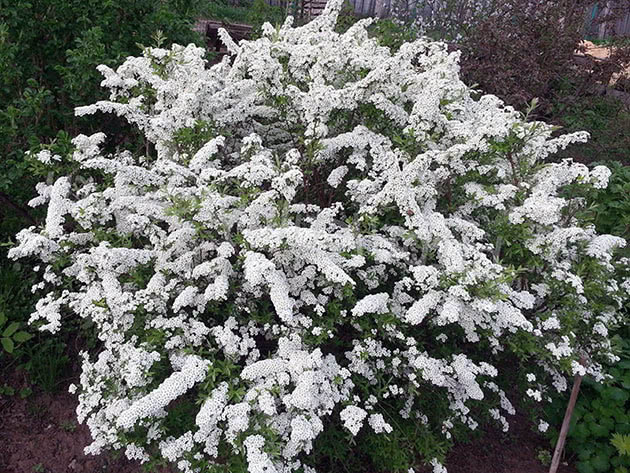
So, in the area where spiraea will grow it is necessary to make a planting hole with steep walls and that will be at least one third more than the volume of the rootball of the seedling. Then you need to leave the hole for 2-4 days. On the day of planting (rainy or cloudy weather is preferable) it is necessary to make a 6-8 inch drainage layer out of broken bricks, especially if the soil is clay, add 2 parts of leaf or turf soil and one part of peat and sand, mix it, set the roots of spirea into the hole, spread them, fill the hole with the soil until the root collar and then tamp the soil around. Immediately after planting, spirea is watered with one or two buckets of water and mulched with peat.
Planting of spirea in autumn
In autumn both spring-blooming and late-season blooming spireas are planted. Usually the autumn planting is combined with division of the bush. You should do this until the end of leaf fall. You can also divide and transplant spirea that is 3-4 years old or even older, but this can be quite difficult because of a large soil clod that is not easy to extract and wash.
The spirea bush should be dug out within a little more than half of the crown projection. You'll probably have to chop off a few roots, but this will not do much harm to the plant. Then the roots of the extracted bush need to be washed well. If the plant is young and not very overgrown, just put it in a container of water and let the soil soften and sediment, then rinse the roots under running water while straightening them. Using a secateur, cut the bush into two or three pieces so that each cutting has good roots and 2-3 strong shoots. Align the cord-like roots.

Dig out a hole, make a mound at the center of it, set a seedling in the mound and level the roots. Fill the hole with the soil and tamp it around. Pour the plants with water in several steps.
Care of spirea
How to care for spirea
We have already outlined the basic requirements of spirea: a bright light (although many species grow well in the half-shade), a loose fertile soil, a good drainage and mulching with a 2.7 inch peat immediately after planting. What else is needed for spirea to please you with a beautiful and long-lasting flowering?
Since spirea has a shallow root system, it does not tolerate dry soil and begins to dry up, so it needs moderate watering in the dry spell: 3.3 gallons of water per bush twice a month. Soil loosening and regular weeding are mandatory. Fertilizing is carried out with a combined mineral fertilizer after pruning the bush, and in the middle of summer it would be good to fertilize the spirea with a solution of the mullein with the addition of superphosphate at the rate of 0.35 oz per 2.2 gallons of solution.
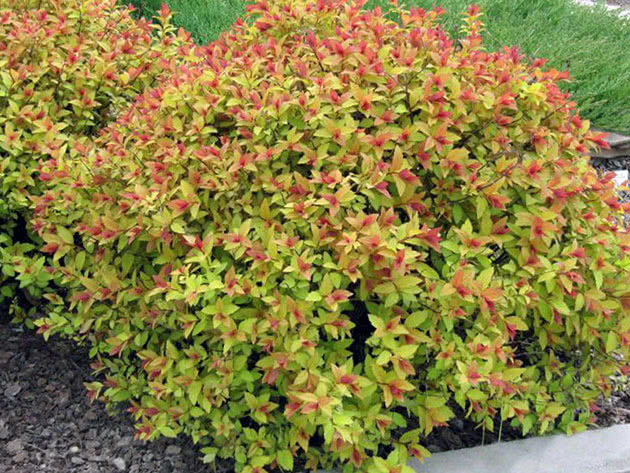
The pests that annoy spirea most of all are aphids and spider mites. The spider mites are destroyed by malathion (carbophos), and aphids are controlled by an insecticide. But spirea is not generally susceptible to diseases, and pests can not do much damage to its beauty and reduce its ornamental qualities.
Pruning of spirea
The bushes are prone to overgrow, so you have to trim them periodically. If the plant is an early-flowering and its blossoms grow along the entire length of the shoot, only frostbitten ends of branches are cut off annually, but in 7-14 years all old shoots should be removed, that is, the plant is cut almost to the stump, then 5-6 strongest young shoots form a new bush, removing the remaining shoots during vegetation. In a year or two weak or old shoots should be removed again. The ends of the shoots should be pruned in spring, before the leaves appear, the sanitary pruning of the old shoots can also be carried out in spring, or even in summer.
Summer-blooming spirea is pruned annually in early spring. The shoots should be shortened to large buds, weak and small shoots should be removed at all. The more you prune, the more powerful the shoots will be. It is necessary to remove aging shoots in time, otherwise they begin to dry up on their own. When the bush is four years old, you can annually cut the shrub to a height of 12 inches from the ground, but if even after this pruning the spirea produces weak shoots, you should consider replacing the bush, although on average the late-flowering spireas live for 15-20 years.
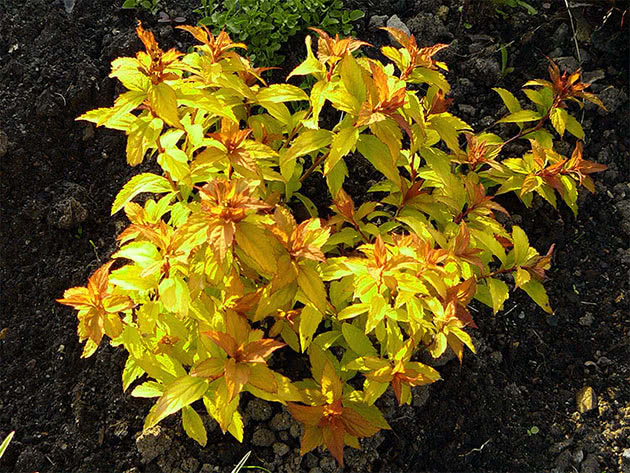
Propagation of spirea
Spirea is propagated by seeds, cuttings and layers, in addition to the bush division. Only those spireas that are not hybrids can be propagated by seeds, because the seeds of spirea do not retain varietal qualities. Propagation by cuttings, on contrary, yields very good results – over 70% of the cuttings take roots even without the use of growth stimulants. Early-blooming spirea cuttings are planted in the first half of June, late-blooming cuttings are planted in the second half of June or in July. The lignified cuttings are rooted in autumn, in September-October.
Cut out a straight one-year old shoot, slice it into pieces, so that each one has 5-6 leaves. Lower leaves should be removed with the petioles, the remaining leaves should be cut a half of their length and put the cuttings in a solution of root hormone (0.035 oz per 70 oz of water) for half a day. Then process the lower node of the cuttings with a root hormone and plant them in a pot with a moist sand at an angle of 30-45 degrees. Cover the cuttings with a glass or foil. Place the container with cuttings in shade and spray them with water two or three times a day. When frosts come, cover the cuttings with soil and leaves, put the inverted box over them and leave them until spring. When the cuttings give new shoots next year, they can be planted out on a permanent place.

When propagating by layers, the shoot is placed in a groove dug in the ground, pinched and slightly covered with the soil. If you want to get several new shoots, then the tip of the layer should be clipped, then each lateral bud can give a new offspring. In autumn the layers are carefully extracted and divided into grown shoots that are then planted out.
Spirea after flowering
As already mentioned, care of spiraea is simple, as well as its preparation for a dormant period. Almost all species and varieties of spirea tolerate colds well, but if winter is very frosty and snowless, you should take care of the plant by covering the roots of the bush with a 4-6 inch layer of foliage. In any case, it will do no harm.
